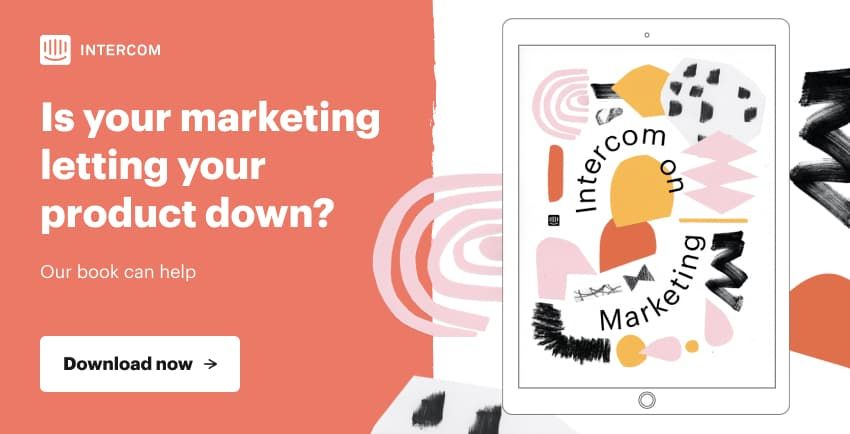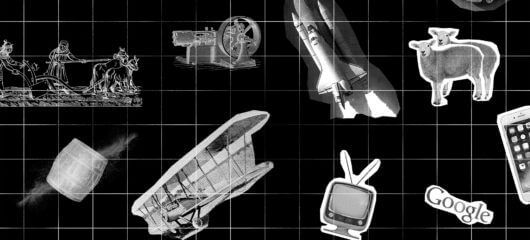
Matt Hodges on aligning product and marketing
Product marketing is about getting people to understand not just what you're building, but why they should care about what you're building.
I gave a talk on Intercom’s “Lessons Learned” tour about the need to tell a better Intercom story, one that captures people’s attention and motivates action. Below is a loosely edited transcript. Short on time? Here are some quick takeaways:
- A successful, sustainable business is not just built on having a great product alone. Rather, it requires the synergy of great product and great marketing.
- When you first start marketing, your goal should be to help communicate to the world what you are building and why people should care.
- Be wary of the common traps of product marketing.
- When you build something, take the time to align product and marketing on the story you want to tell at launch.
If you prefer video, we’ve also released my talk on YouTube.
G’day! I’m Matt, and I was Intercom’s first Australian. But that’s not why I’m here.
I was also Intercom’s first marketer, so I want to share the lessons I’ve learned being the first marketer at a product-first company like Intercom. Let’s start by rewinding the clock to about three and a half years ago, when there were just 50 people at Intercom, most of them in R&D.
“The product almost completely sells itself”
We had just hit $1.2M in ARR and raised a $23M Series B. On average, there were about 750 new Intercom apps created every month. Our growth was primarily due to word of mouth from amazing customers like a lot of you (thank for that, by the way). And of course, there was Des Traynor’s prolific blogging on Inside Intercom. I’m sure you’ve all read a few of his posts. The man’s a genius, and he’s my boss, so I’m paid to say that.
But, it wasn’t until two years after launching Intercom that Des, and our CEO, Eoghan, decided it was time for marketing. And I have proof! I dug up the original LinkedIn InMail I received back in January 2014 – yes, I did actually read them, but not anymore. Eoghan wrote that “the opportunity for Intercom to become a multi-billion dollar business is largely a marketing challenge.”
I couldn’t agree more. So, I kept on reading:
“The product almost completely sells itself.”
Right, I’ve heard that one before. Bullshit.
“We have double-digit growth and revenue in the millions and have spent nothing on sales and marketing.”
Now, I’d never heard of Intercom at the time, but I’m thinking Holy shit, here’s another Atlassian, which is where I was working at the time.
“The next step change in growth for the company will come from explaining to the world what we’re building and why.”
Now I was thinking, That’s something I can help with.
So, after a couple of beers with Eoghan and then a few scoops with Des (which I’ve since come to learn are what the Irish call tiny little pints), I became Intercom’s first marketer. That’s literally how it happened. I will say that our hiring process is a little different these days. Thank god I joined backed then, because I’m not so sure I would get hired again today.
“Sustainable business is not just built on having a great product alone”
Nonetheless, three and a half years on, we’ve increased the number of people signing up to try Intercom by 1,400% and grown ARR from $1 to $50M.
And that was all ME! (I’m kidding, of course.) This growth is down to the hard work of a lot of people across the company and our amazing customers. We’ve been so fortunate.
At the same time, the other thing that’s grown is the size of the marketing team. It’s gone from a team of 1 to 45. That continued investment in marketing didn’t just happen. I, and others, had to fight for it. Why do I say it was a fight? Remember what Eoghan said in that InMail? “The product almost completely sells itself.” That, my friends, is a classic product-first mentality.
The product-first mentality
But fortunately for me and for Intercom, Eoghan was (and still is) a big believer that a successful, sustainable business is not just built on having a great product alone. Rather, it requires the synergy of great product and great marketing. The two are a dynamic duo of sorts, just like Batman and Robin. No one gives a shit about Robin, but Batman wouldn’t be Batman without him.
Of course, not everyone feels that way, so they need some convincing.
And I think it’s because of those two words: “product first”. We say it to anyone who’ll listen. We thump our chests when we say it. It turns out it’s a really attractive selling point when trying to hire new talent, myself included.
“Product first” is implicitly set up in contrast to what came before it. And we’ve been on a journey for the past couple of decades. It’s easy to forget, but wasn’t too long ago that pretty much all software companies were primarily sales first, and product second. The mentality wasn’t “build it, and they will come”. It was more like “sell it, and then tell the product team to go build it”.
“You’ve got an environment that makes switching a whole lot easier, cheaper and palatable”
You’d build whatever people would pay you the most for, which meant your biggest customers ended up dictating your roadmap. As a result, your product quickly turned to shit and started to look like Frankenstein. But even though it was slow, clunky and awful to use, you still got paid because your customers were locked in.
But in 2002, along came a little Aussie startup called Atlassian, which you might know better for JIRA. They became famous for their new approach to selling software: no salespeople. And it worked. You could try any of their products for free for 30 days without speaking to anyone unless you wanted to, of course.
In addition, their prices were so incredibly low that you, the end-user, could buy any or all of their products for your whole company on your personal credit card. That changed the game.
And then along came SaaS.
It used the same model: try before you buy, plus a bonus in that you didn’t have to install anything. This further reduced the barrier to adoption and made it possible to evaluate alternatives to the shitty products you were forced to use at work. Combine that with monthly subscriptions instead of annual contracts, and you’ve got an environment that makes switching a whole lot easier, cheaper and palatable.
So how do you compete in this new world? Simple: you create the best product and it will sell itself.
Who needs sales, or marketing, for that matter? All you need to do is achieve product market fit and word of mouth will work magic on its own, right? And that’s how the product-first mentality was born. Everything centers around building an amazing product that customers love, and everything else comes second.
Internally, the product team is put up on a pedestal, and not having a marketing team is something that’s celebrated. In fact, Fred Wilson, the co-founder of Union Square Ventures, wrote a blog post called “Marketing”, in which he said that “marketing is what you do when your product or service sucks”.
Fred, I’m sorry mate, but anyone who thinks marketing cannot add value to and accelerate the growth of your business is just plain naive and ignorant. That said, if someone as successful and influential as Fred believed this, then it’s not surprising that others were getting drunk on the product-first kool-aid, too.
Marketing in the SaaS world
That’s what I walked into when I became the first marketer at Intercom. I was starting at level 0, and I had a lot to prove. It was like being the green chat bubble in an iMessage conversation. You’re the odd one out. People don’t get why you’re there. You’re annoying, even.
Think about it: when I walked in, the company had grown to 50 people and was doing really well. And a bunch of those 50 people were already wearing their own little marketing hats; they just didn’t know it. There was already a blog, a damn successful one. The product managers were already launching new product and writing the product announcements. And then there was the CEO, who was wearing the biggest marketing hat of all and working with a designer on the marketing site. So while there was no formal marketing team at Intercom, marketing was very much alive and well. It just wasn’t acknowledged.
I think this is the case at most startups that would call themselves product first, where marketing is a dirty word. Why is that? I think all comes down to a fundamental misunderstanding of marketing’s role.
“It was like being the green chat bubble in an iMessage conversation. You’re the odd one out”
In the new world of SaaS, marketing should be involved at every stage of the funnel: from the first point of contact to the decision to purchase to ongoing product education. That’s why it’s a mistake to think that marketing is a single team. In fact, it’s an umbrella term for a bunch of teams – each with differentiated sets of core skills – that are all united around a shared idea of creating, capturing and converting demand.
You’ve got all these teams, each wearing their own marketing hats. There’s Events, Communications, Demand Generation, Content, Product Marketing, Product Education and Brand Design. That’s seven, if you were keeping count. And we need more as we grow and get more sophisticated.
Doing all this is hard. And doing all this well is really hard.
But you shouldn’t shy away from it because without it – if you build it and they do come – they’ll most likely be confused about what your company stands for and what your product can do for them. They’ll close the tab and move on with their lives. Well done, “Mr. or Ms. We Don’t Need Marketing”.
Where do you start?
For us, it started with hiring a product marketer (me) to help communicate to the world what we were building and why you should care. We started there because there’s absolutely no point in spending a bunch of money to acquire new customers if you haven’t got this right first.
Just as Simon Sinek, the best selling author of Start With Why, says, “People don’t buy what you do, they buy why you do it.”
My first priority was overhauling the homepage of the marketing site, which is the first and unfortunately, for most, the last impression people get when they discover your product for the first time.
“People don’t buy what you do, they buy why you do it” – Simon Sinek
Remembering back to that InMail, the first thing I did was head over to Intercom’s website to find out what they actually did. “Simple, personal messaging for businesses and their customers,” I read.
The first thing I thought was, “Huh, sounds a bit like HipChat”, one of the Atlassian products I was working on at the time. Of course, Intercom is nothing like HipChat.
It wasn’t until I invested more time reading and got stuck into a few posts on the blog that I really got a sense for what Intercom was and what they were trying to do, which was actually create “an entirely new way to connect with your customers”.
That was my new message.
You have to remember that most people won’t invest that extra time to learn what it is that you actually do. They’ll just bounce. Literally.
That’s why your homepage is so important and where I started first. It was my first win at Intercom. I’d scored some points and reached a new level, but I was really just getting started.
Next up was winning the hearts and minds of our product managers: Brian, Colin, Michelle and of course Paul, our VP of Product. Funny story: I actually broke Paul’s thumb after just three months on the job. He fell over my leg in a friendly game of football. If you type “paul_thumb” into our Slack, you’ll get this sweet emoji:

The poor guy couldn’t write an email for a good couple of months after that, which I actually think Brian, Colin and Michelle really appreciated.
“The worst thing you can do is make too much noise and create a bunch of hype your product simply cannot live up to”
Anyway, my goal in working with the product team was simple: show them how marketing could amplify the work they were already doing without getting in their way. They were building and releasing all this really cool stuff, but they weren’t doing the product any justice in how they told customers about all that new stuff. In fact, most of the time they weren’t telling anyone.
The fact is that, done well, product announcements can lead to step-changes in growth for your business. That’s certainly been my experience at both Atlassian and Intercom.
If you look at traffic our marketing site and new sign-ups, it looks a little like a staircase: a big spiky one with step changes that coincide with our bigger product announcements.
The common traps of SaaS marketing
So, the first thing I did was develop a framework for our approach to announcing new product. You can read all about it on Inside Intercom since we don’t have time to dive into it tonight. But I bring it up because establishing that framework was crucial as there are a few common traps that are easy to fall into.
1. Don’t treat every announcement equally
You treat everything equally, and you shout about everything because you assume people care about every new thing you ship. They don’t.
If you make the same big deal about your “redesigned sign-in page”, as you do about your, “AI-powered, AR-driven bot”, I guarantee you people will stop listening to you.
One deserves attention. One does not.
2. Don’t assume the difficulty of building something is the same as how much it matters to your customers
You assume that because something took a lot of time or was really hard to build, that people will care about it. I know it was a really hard problem to solve, and it took you six months, but our customers probably won’t give a shit.
Sorry.
3. Be wary of over-promising and under-delivering
This the most common, especially once you add marketing to the mix, so be hyper aware of it: you over-promise and under-deliver.
Here’s an example: you build hype that you’re going to change the way everyone sees the world. You start calling your users “explorers”, and eventually you ship a pair of $1,500 glasses with only one lens that makes you look like an asshole. (Sorry, Google.)
The point is, in a world where you’re constantly competing for people’s attention, you need to be really thoughtful about what you choose to announce and how. Doing so will help you maximize the impact of the things you really do want people to pay attention to.
“A good story captures people’s attention and motivates action”
The worst thing you can do is make too much noise and create a bunch of hype your product simply cannot live up to. If you do that, people will stop trusting you, and you’ll end being the app that cried wolf.
Avoiding these traps all starts with setting expectations inside the company, like explaining why we’re not going to get TechCrunch to cover this new feature you spent months building and why we didn’t create a new landing page for that new thing that was really hard to build.
Usually, it’s because there’s not a great story to be told. This is probably the most important piece of effective marketing. A good story captures people’s attention and motivates action.
I had to show the product team the value of storytelling. Let’s go back a few years and take the first announcement I worked on as an example: “You can now track custom events in Intercom!”
That’s not what I said, but if I’m being completely honest, that’s probably what the announcement would have looked like if I hadn’t been involved. Sure, it accurately describes what’s new, but it doesn’t tell me why I would want to use it.
The value in the Events feature was actually that it let you send messages to customers at the perfect time. So that’s the story I told. It focused on highlighting all the things people wanted to do because they understood the value in doing them.
We’d never done this before, and it was another win for me. Another level up. I was making progress. I think it actually led to the PMs thinking, “Maybe we should talk to that Australian lad in marketing before we’re ready to ship something.”
Finally! Any product marketers reading? You know how big this was.
A seamless, asynchronous messaging product
Let’s take a look at the launch of our first new product since I joined. I wanted to launch Acquire as our “live chat” product, but the product team was adamant that live chat was a relic of the past and what we really need to take to market was a “seamless, asynchronous messaging product”.
You heard right. That’s Paul Adams’ marketing at its best right there. I actually have this in an email from Paul. I’m not making it up. I’ll send it to you if you like. I remember reading it and thinking, Seriously, mate, are you kidding me?
Of course, I didn’t say that. It wasn’t that Paul and the product team were wrong. They were actually 100% correct. We just had our own biases.If it’s the product team’s job is to innovate and build the product of the future, then it’s marketing’s job to make sure people a) find that product and b) understand it and c) convince them why they need it.
When we launched Acquire, there were more than 100,000 global monthly searches for “live chat software”, but next to nothing for “asynchronous messaging”. Exactly.
Now, Paul would tell you we needed to help build a bridge to the future, and he’s right. But I would tell you we had to get them to the bridge first. And that’s where marketing can help.
If we’ve learned anything over the last three years, it’s that you need to start with the story before you build anything.
This is not about marketing dictating what to build; rather, it’s about getting aligned on the position you want to hold in people’s minds, which is intrinsically based on the problem you’re solving.
We learned this the hard way with the launch of our newest product, Educate, which shipped in December last year. As we were getting closer to the planned launch, it became clear that product and marketing weren’t aligned on what we were building and how we planned to take it to market.
“Start with the story before you build anything”
What happens when things are misaligned? Bad things.
This small exchange between Paul, our VP of Product, and Raechel, a product marketer on my team, sums it up well. This was in a meeting about about six weeks out from when we thought we’d be ready to launch.
Paul: “Educate is not a docs product,”
Raechel: “Why does our help center, powered by Educate, live at docs.intercom.com, then?”
Crickets. Houston, we have misalignment.
That led us to make a really tough call to delay the launch by a few months. This was bad, since launching Educate was one of our company’s goals, and our financial forecasts were dependent on it shipping on time.
In hindsight, it was absolutely the right decision. But knowing that after just two months on the market Educate was a $1.2M ARR product and growing, we were able to put a dollar amount on how much that misalignment cost us. You can do the math.
It was a very expensive inefficiency in our process. We simply had to learn from it.
Alignment between product and marketing is key
If you fast forward to today, anything that’s planned to take more than a week to build starts with product and marketing aligning on the story we want to tell at launch. This has been a fundamental shift in how we build new product at Intercom. I’m a little biased, but I like to think that’s been my biggest win of all.
Don’t get me wrong; there’s still a lot of tension in getting that story right and getting aligned, but it’s a healthy tension that we believe leads to a better solution for our customers at the end of the day.
I’ve barely scratched the surface of the role of marketing now plays at Intercom, and while we still hear it all the time: “We’ve got a great product. Now we just need to add marketing.”
“Doing all this is hard. Doing it well is really hard”
I hope I’ve convinced you that there’s a lot more to it than that. After all, if someone said, “We have a great product; we just need to add code”, I think we’d all laugh at them. One doesn’t exist without the other, just like our friends Batman and Robin.
We didn’t grow from $1to $50M in ARR in the last three years and bring 20,000 customers with us along the way by just being product first. As a very wise man once said, “If you built a great product that no one heard about, did you build a great product?”
Product and marketing are two sides of the same coin, so respect them as such.
If you enjoyed this article, check out our other talks from the 2017 Inside Intercom world tour:
- Brian Donohue’s Builder beware: marketing tension in product-first companies
- Des Traynor’s Lessons learned from scaling a team
- Emmet Connolly’s Design in Interesting Times
- Jeff Gardner’s How to tell your company story
- Sabrina Gordon’s Growing your customer support team
- Greg Davis’s Myths of product market fit
- Sharon Moorhouse’s 5 lessons learned from growing a support team








